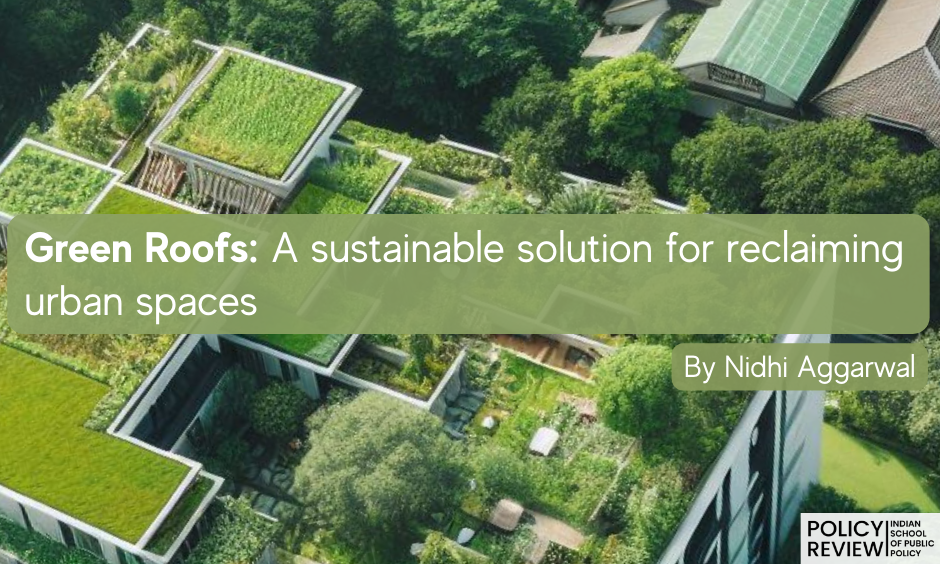
Green roofs: A sustainable solution for reclaiming urban spaces

Concrete jungles, polluted spaces, flash floods, and heat islands – all these words have become synonymous with urban areas. The NITI Aayog has estimated that almost 65% of the energy produced in India is utilised for space cooling and heating. This usage is projected to rise eleven-fold by 2037-38 (Michael & Gautam, 2023). So, what can be done to combat these pressing issues at a policy level? How can we reclaim urban spaces? The answer lies in the mass adoption of green roofs.
Green roofs or living roofs are roofs covered with live plants. The vegetation is planted on the top of a standard structure and waterproofing elements of a regular roof. Inspired by natural habitats, green roofs regulate atmospheric temperatures and absorb pollutants. Typically, they include structural support, roofing membrane, protection, root barrier, insulation, drainage, aeration, water storage, and a nutrient rich medium for plant growth.
Why do I say green roofs are solutions to the many problems our cities face today? Let us start by understanding where these systems, or ecosystems, can be installed.
Green roofs can be practically installed on any roof. For instance, government and private offices with large, empty roofs are perfect sites to install green roofs. Doing so will also address the issue of space crunch in urban areas. Even a space as small as a bus shelter can be leveraged to introduce city greenery. Individual households can also install green roofs. Now that we have answered the where question let us address the need for such structures in cities.
The greatest advantage of green roofs is that they introduce greenery in concrete jungles, increasing both aesthetic and health benefits. Green spaces benefit not only residents but entire neighbourhoods as they positively impact health due to improvements in air quality, stress reduction, increased physical activity and improved social cohesion (Hartg et al.,2014).
Next, green roofs hold rainwater and thus reduce surface runoff. They can retain 70 to 90 per cent of precipitation falling on them in summers and 25 to 40 per cent during winters. Diverting this captured water into a rainwater harvesting system recharges the groundwater. Studies show that green rooftops can control stormwater runoff by lowering and delaying the peak of the water runoff process (Bengtsson et al., 2005). The water that passes through the green roofs is naturally filtered. Thus, green roofs help in the conservation and recycling of water.
Moreover, the plants and vegetation added to the otherwise heat-absorbing surfaces reduce the urban heat island effect which helps lower urban air temperature. According to the US Environmental Protection Agency Report, green roofs can lower ambient city temperatures by up to 5°F by lowering the temperature of conventional roofs by 30 to 40 degrees Fahrenheit. Additionally, green roofs can reduce energy usage in buildings by 0.7% compared to conventional roofs.
This reduction in urban energy demands can, in turn, reduce the greenhouse gas emissions in the cities. Green roofs also directly help reduce air pollution and global warming by capturing harmful gases. Modelling studies (University of Surrey) found that green roofs can reduce air pollution by 30-57 per cent. Besides the environmental benefits, scaling green roofs will help create many job opportunities. These include jobs in manufacturing, plant growth (gardeners), design, installation, and maintenance. In addition to the benefits, green roofs also positively impact biodiversity. The ecosystems created by green roofs provide habitats for biodiversity vanishing from urban spaces like bees and butterflies.
However, despite the benefits, uptake for green roofs is slow, especially in India. Primary challenges include huge construction costs, excessive renovation and maintenance costs, and roof leakages. Additionally, green roofs are heavier and require more structural support. But from the above discussion, the benefits outweigh the challenges. Also, these challenges can be mitigated by collective action and policy support like the 2002 amendment to the City of Basel Building and Construction law which mandated all new flat roofs to be greened. Today, Basel has the largest green roof per capita in the world (Giannopoulou et al., 2019).
It is, therefore, essential to add green roofs to policy actions like- Pradhan Mantri Awas Yojana and Smart Cities Mission by making them an integral part of urban planning. As seen above, green roofs can help reduce urban energy requirements. So, green roofs can and should be included in policy plans on achieving India’s Cooling Action Plan. Europe is an excellent example of the successful implementation of green roofs. This has also translated into environmental, economic, and health benefits for European cities and their dwellers(Versini et al., 2020). Countries like Singapore, China, and the USA are actively following in Europe’s footsteps.
Reducing greenhouse gases and air pollution by green roofs can help fast-track India’s goal to achieve net zero emissions by 2070.
In conclusion, integrating green roofs is a sustainable solution to urban areas’ pressing challenges. Green roofs address space crunch issues resulting from planting trees in and offer many benefits like improving air quality, reducing stress at the individual level, and at a larger level, aiding in, urban flash flood mitigation and curbing the urban “heat island” effect.
Beyond the environmental advantages, the economic potential and positive impact on biodiversity underscore the holistic nature of this solution. Learning from practical examples, India should wholeheartedly embrace this unique combination of nature and technology. It will help make its cities greener, cleaner, healthier, happier, and prosperous. So, let us join hands and make this “Azadi ka Amritkaal” a “Harit Shehar kaal.”
1 A flood caused by excessive rain in a short duration, usually 6 hours.
2 Collection and storage of rain, rather than allowing it to run off.
3 The phenomenon of cities having warmer temperatures compared to the surrounding rural areas.
4 Integrated vision towards cooling across sectors encompassing, inter alia, reduction of cooling demand, refrigerant transition, enhancing energy efficiency and better technology options by 2037-38.
5 Removal of carbon dioxide from the atmosphere balances the amount of carbon dioxide released in the
atmosphere.
References:
- Deshpande, T. (2023, June 30). Explained: As Indoor Heat Rises, Can India Turn To Green Roofs? https://www.indiaspend.com/explainers/explained-as-indoor-heat-rises-can-india-turn-to-green-roofs-867308
- Giannopoulou, M., Roukouni, A., & Lykostratis, K. (2019). Exploring the benefits of urban green roofs: A GIS approach applied to a Greek city.
- Michael, J., & Gautam, S. (2023, September 2). DTE Call For Action: Can India achieve ‘sustainable cooling’? Down to Earth. https://www.downtoearth.org.in/video/energy/dte-call-for-action-can-india-achieve-sustainable-cooling–91516
- Matos Silva, C., Bernardo, F., Manso, M., & Loupa Ramos, I. (2023). Green Spaces over a Roof or on the Ground, Does It Matter? The Perception of Ecosystem Services and Potential Restorative Effects. Sustainability, 15(6), 5334. https://doi.org/10.3390/su15065334
- Shafique, M., Kim, R., & Kyung-Ho, K. (2018). Green Roof for Stormwater Management in a Highly Urbanized Area: The Case of Seoul, Korea. Sustainability, 10(3), 584. https://doi.org/10.3390/su10030584
- Tomson, M., Kumar, P., Barwise, Y., Perez, P., Forehead, H., French, K., Morawska, L., & Watts, J. F. (2021). Green infrastructure for air quality improvement in street canyons. Environment International, 146, 106288. https://doi.org/10.1016/j.envint.2020.106288
- US EPA, O. (2014, June 17). Using Green Roofs to Reduce Heat Islands [Overviews and Factsheets]. https://www.epa.gov/heatislands/using-green-roofs-reduce-heat-islands
- Williams, K. J. H., Lee, K. E., Sargent, L., Johnson, K. A., Rayner, J., Farrell, C., Miller, R. E., & Williams, N. S. G. (2019). Appraising the psychological benefits of green roofs for city residents and workers. Urban Forestry & Urban Greening, 44, 126399. https://doi.org/10.1016/j.ufug.2019.126399
- Versini, P.-A., Gires, A., Tchiguirinskaia, I., & Schertzer, D. (2020). Fractal analysis of green roof spatial implementation in European cities. Urban Forestry & Urban Greening, 49, 126629. https://doi.org/10.1016/j.ufug.2020.126629

Nidhi Aggarwal
PDM Scholar, Class of 2024,
Nidhi Aggarwal is a policy analyst exploring the role of technology and innovative solutions for sustainable development. With experience in research, writing, and community work, she analyses governance through an interdisciplinary lens. Nidhi is currently pursuing her PGP in Public Policy, Design and Management at the Indian School of Public Policy, New Delhi. Her interests include urban issues, climate action, and sustainable development.

